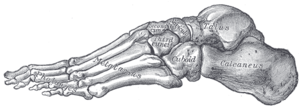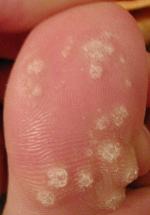
- Image via Wikipedia
One money-saving tip for each toe:
For one big toe: Gout. You don’t need prescription medication to treat gout (usually). Save yourself an office visit by using OTC anti-inflammatory drugs such as ibuprofen, naproxen, or aspirin for under $5. If you do need a prescription, print out a copy of the $4 list from your local pharmacy and take it to your doctor – many $4 options are available. Learn more about gout at: http://mayoclinic.com/health/gout/DS00090

- Image via Wikipedia
For the other big toe: Ingrown nail. Prevention is best if at all possible. Make sure you cut your nails such that sharp corners cannot pierce your skin. Most so-called ingrown nails are not exactly ingrown; rather the edge of the nail has grown too far into your skin, causing irritation and sometimes infection. Avoiding undue pressure on the nail, i.e. properly-fitted shoes, helps prevent recurrences. Occasionally an infected nail can be permanently cured with a $4 antibiotic. However, these infections tend to recur and eventually require excision of the lateral portion of the nail. Some doctors advise this minor surgery for the first occurrence, to save pain, time, and aggravation on future recurrences.
For one pinkie toe: Fractured toe. If you’ve stubbed your little toe on the bedpost and think it’s broken, you may well be correct. If there’s no visible injury or deformity other than swelling, simply stabilizing it by taping it to the adjacent toe is a reasonable treatment and only costs a penny. If there is an open wound overlying a potential fracture, you want to be careful, lest infection invade the underlying bones. Also, a broken big toe can cause gait instability or other chronic problem, and is good reason to see your doctor.

- Image via Wikipedia
For the other pinkie toe: Wart. Plantar warts are commonly treated with cryotherapy (freezing therapy) by physicians. Now you can freeze your own warts using inexpensive over-the-counter cryotherapy devices. Dr. Scholl’s Freeze Away®, Wartner Cryogenic Plantar Wart Removal System®, or Compound W Freeze Off® are each available online or through your local drugstore for under $25. If you’re brave enough to stand the sting, do it yourself and save hundreds of dollars. But read the directions closely – better to under-treat than over-treat to start with.
For toe #5: Nail fungus. You have the option to treat or not to treat. Nothing over-the-counter is very effective. Even prescription medication is not terribly reliable, though the cost has dropped dramatically in the past few years. Drugs that used to cost $100 are now as little as $4 a month. Also keep in mind some nails that look infected with fungus have been damaged instead, either due to acute or chronic injury, or even psoriasis. Next time you see your doctor for a different problem, take your shoes off and ask if he or she thinks it’s worth doing anything about your thick, yellow nails. Educate yourself before you go by reading http://www.mayoclinic.com/health/nail-fungus/DS00084. For some good pictures see http://www.dermnet.com/Distal-Subungual-Onychomycosis.
For toe #6: Raynaud’s phenomenon. If you’ve been diagnosed with this circulatory condition the most important thing is to keep your hands and feet warm using socks, gloves, and/or hand and foot warmers. Keeping the center of your body warm – your chest and abdomen – helps as well, because this allows your body to shunt more blood to your extremities. Most people require no medication, though some patients do well with certain blood pressure medications that dilate the blood vessels. Save money by staying warm.
For toe #7: Subungual hematoma. If you’ve dropped a hammer on your toe and developed a painful black bruise underneath the nail you have two options: live with it or consider relieving the pressure caused by the trapped blood. Keep in mind if the toe is painful, not just the nail, you may have fractured your toe (see above). Also, if you are diabetic or have poor circulation, you should probably see your doctor rather than treat at home. For healthy individuals, relieving the pressure oneself is an option – for the cost of a paper clip. For a good video of how a doctor would treat this condition see: http://www.youtube.com/watch?v=x7yNSVDg_l4.
For toe #8: Athlete’s foot. Several prescription anti-fungal medications are now over-the-counter, among them Lotrimin® and Lamisil®. The “tricks” to getting rid of athlete’s foot are consistent use of the medication (until the rash appears to be gone plus one additional week) and avoiding re-exposure, i.e. – getting rid of contaminated shoes. Treat yourself for under $10 using a generic. Occasionally what appears to be athlete’s foot is an allergy or other type of infection, so see your doctor if your symptoms persist.

- Image via Wikipedia
For toe #9: Bunions, hammer toes, arthritis, diabetes. Have your shoes sized professionally, preferably at a specialty store. Though you may have worn a size 8A in high school, a 9C may be what you need. A $200 pair of shoes may save you thousands on toe surgery or diabetic foot ulcer treatment. If your foot is misshapen, ask about stretching your shoe in the appropriate area. For diabetics at risk of foot ulcers, Medicare (and sometimes private insurance) will pay for diabetic shoes.
For toe #10: Metatarsalgia. If your doctor has diagnosed this condition, or if you have chronic pain across the bottom of your foot at the base of the toes, in addition to properly fitting shoes a metatarsal bar may help relieve your symptoms. Metatarsal bars are available from specialty shoe stores, orthopedic supply stores, and many online vendors for under $20. The device redistributes your weight away from the joints where your foot bones meet your toe bones, and may save you a trip to your doctor.
Based on my own patient population, at least 1 in 100 patients seeks medical advice for foot problems that could easily be treated at home.
Potential annual savings on office visits for minor foot problems: 1,000,000 patients x $50 = $50,000,000 annually.
© Cynthia J Koelker, MD – All Rights reserved
Related articles
- Ingrown toenail – All Information (umm.edu)
- Warts – All Information (umm.edu)
- Athlete’s foot – All Information (umm.edu)
- Bunions – All Information (umm.edu)


